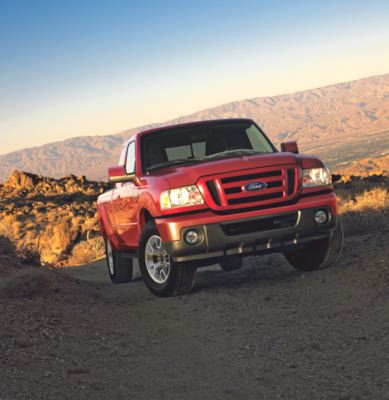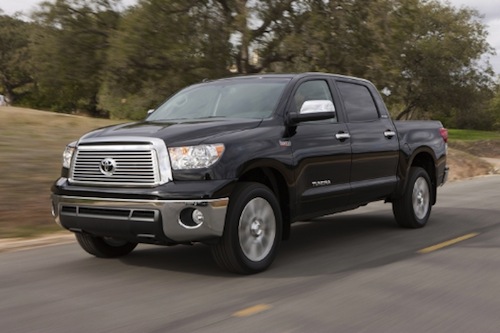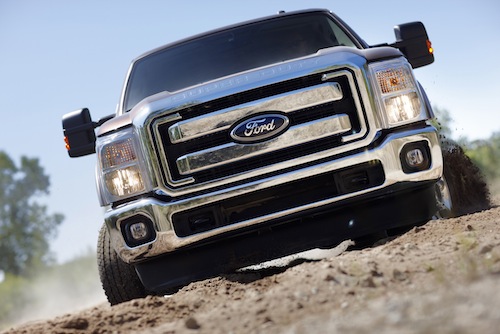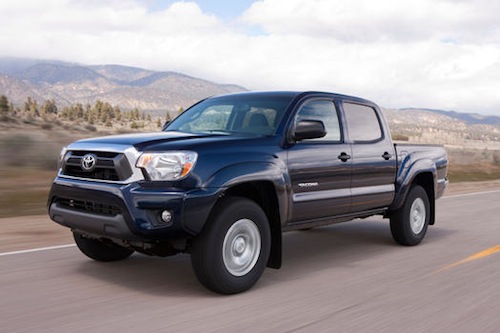Why Large Pickup Trucks Dominate the North American Truck Market
Jason Lancaster | Feb 27, 2012 | Comments 5
There is a curious phenomenon in the U.S. new vehicle market: large pickup trucks are dominant while smaller trucks continue to lanquish. In an era of elevated fuel prices this fact seems at odds with consumer buying habits. However, on closer inspection there are several factors that explain why consumers continue to prefer big over small even as fuel prices continue to rise.

Despite sales success, Ford has discontinued the Ranger. The reason? Big trucks sell much, much better. Image courtesy Ford Motor Company.
Cabin Choices
Most large pickup truck manufacturers offer vehicles that seat three people standard or offer seating for as many as six adults. For work teams, such “crew cabs” are absolutely necessary to transfer workers from job site to job site. These trucks also must carry a heavy load in the truck bed and will sometimes be outfitted with trailering capabilities, pulling more equipment from behind. No small pick up truck can match large trucks in each of these areas.

Crewcab trucks are more popular than ever - which is one reason why bigger trucks continue to outsell smaller trucks. Image courtesy Toyota Motor Sales USA.
Families, too, prize large pickup trucks for the room and utility that these vehicles provide. Many trucks can be as elegantly appointed as a full-size premium sedan. Take the GMC Sierra Denali as an example: this truck features a leather-appointed interior, has heated and cooled front seats and comes equipped with a Bose sound system among other amenities. Large pickup trucks provide family size room and allow its owners to pull a camper or a boat as well as haul cut wood, hay and lumber supplies.
Diesel Availability

North American consumers - many of whom tow heavy payloads cross country - love diesels for their low-end torque. Image courtesy Ford Motor Company.
Large pickup trucks from General Motors, the Chrysler Group and the Ford Motor Company offer heavy duty trucks that feature turbodiesel engines. These engines are more efficient than gas engines and are not available with smaller pickup trucks. One manufacturer, Mahindra, has attempted to bring a compact truck with a diesel engine to the North American market, but that effort failed. Moreover, that Mahindra truck’s EPA rating of 19 mpg city, 21 mpg highway was even lower than what some gas-powered trucks from Ford and Chevrolet achieve, effectively rendering this option pointless.
Diesel-powered pickup trucks also offer top of the range trailiering capabilites. For example, the Ram regular cab SLT edition offers fifth-wheel trailering of 22,700 pounds. That is more than triple the 6,500 pound towing capacity of the Toyota Tacoma, the best-selling small or midsize pickup truck on the market.
Efficient Gas Engines
Smaller pickup trucks such as the Nissan Frontier and Toyota Tacoma offer far superior fuel economy, right? Not quite. The Tacoma, when powered by a 2.7-liter four cylinder engine paired with a 5-speed manual transmission delivers an EPA-rated 21 mpg city, 25 mpg highway. The Frontier, when equipped with a 2.5-liter four cylinder engine paired with a 5-speed manual transmission falls further afield, delivering just 19 mpg city, 23 mpg highway. A Ford F-150 equipped with a 3.7-liter V-6 achieves 17 mpg city, 23 mpg highway, matching the Frontier on the open road while coming very close to offering what the Tacoma gets.

Despite the smaller size, the Toyota Tacoma isn't much better in terms of gas mileage than a full-size truck. Image courtesy Toyota Motor Sales, USA
These mere differences haven’t been enough to persuade large pickup truck buyers to switch to smaller trucks. Indeed, the Ford Motor Company dropped its Ranger as demand for it has continued to fall as buyers preferred the F-150.
Price Differentials
The starting price for large pickup trucks is in the low 20s or just a few thousand dollars more than what you would pay for a Suzuki Equator, a Chevrolet Colorado or a Toyota Tacoma.
The Ram 1500 starts at $21,820 which was just a few thousand dollars more than the now discontinued (Dodge) Ram Dakota. The fuel economy differences were negibile, the 1500 offers a larger interior, more utility options and multiple trim levels. The profit lines for larger trucks is wider too which is why the Chrysler Group invests in larger trucks while discontinuing the Dakota.
American manufacturers have had difficulty competing in the small truck markets even with a 25 percent tariff on small trucks imported to the United States. Even then, the only way GM can build small trucks in America is because of its ability to hammer out an agreement with its union to ease up on pay demands. Ford doesn’t have that edge and has declined to replace the Ranger although a new body on frame model is built in Thailand and available in numerous markets.
Looking Ahead
Demand for smaller pickup trucks has been declining for the past decade. However, small pickup trucks may begin to appeal to buyers as new models are brought to the market, offering improved fuel economy and better options. As gas prices top $4 per gallon, demand for large trucks will begin to ease. For manufacturers such as Toyota, Nissan and Chevrolet with appealing products to offer, the small pickup truck market might brighten except, of course, for work crews that rely on the big trucks.
Guest author Matt Keegan is a freelance writer and owner of FordHood, a Ford enthusiasts website. Learn how Ford is using EcoBoost engines to squeeze more power and deliver better fuel economy from smaller engines.
Filed Under: Auto News


I know I could get 30mpg in a Tacoma. It’s simple but no one cares about doing slower speed.
There is also the safety factor. People feel safer in a large pickup surrounded by other large pickups. I would not want to drive s Tacoma on the interstate surrounded by big rigs and F-250’s as is the case here, but I do feel confident in my tundra though it has better visibility and is much better at absorbing wind sheer from other large vehicles.
I really liked my chevy ext. cab S-10 4.3L V6 when it was just 2 people. All I really need before had kids. If I was single, I would get the tacoma no question about it in a v6. Yah, I would only get 23 mpg at best like my s-10 V6 did, but still beats 17 mpg with the tundra. There is a market for small pickups, but not as much anymore agree. Everyone wants bigger is better mentality. I think nowadays most of the younger buyers in the early 20’s would prefer a sports car over a smaller pickup unlike when I was a young lad. GM’s colorado 5 cylinder was a joke and the ford ranger although popular wasn’t much of anything special. Now the dodge dakota is gone which I think is a pretty decent mid-sized slightly bigger option. Only taco is left and don’t think that will go away soon since now it rules the small truck market.
My 07 Tundra Double Cab, 4×4, with the big 5.7 V8 has hit 23mpg but only at 65 mph, cruise control set, only me in it with no payload and driving in the slow lane for 50 miles. But my 6’8″ frame will not fit into a Tacoma.
Nice way to prove .
Large Pickup Trucks Dominate the North American Truck Market the points you mentioned are excellent.